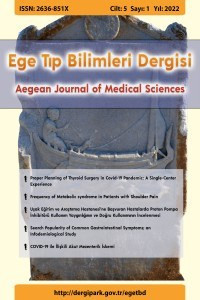Retroperitoneal Metastaz ile Bulgu Veren Burned-Out Seminomatöz Testiküler Tümör, Nadir Bir Olgu
burned-out, retroperitoneal kitle, lenf nodu diseksiyonu, orşiektomi
'Burned-out' Seminomatous Testicular Tumour Diagnosed as Retroperitoneal Metastasis, A Rare Case
burned-out, retroperitoneal mass, lymph node dissection, orchiectomy,
___
- 1. Albany C, Einhorn LH. Extragonadal germ cell tumors: clinical presentation and management.
- CurrOpin Oncol 2013;25:261-265
- 2. Tasu JP, Faye N, Eschwege P, Rocher L, BléryM.,Imaging of burned-out testis tumor: five new cases and review of the literature. J Ultrasound Med 2003;22:515-521.
- 3. Lehmann D, Muller H. Analysis of the autoimmune response in an ‘in situ’ carcinoma of the testis. Int J Androl 1987;10:163-168.
- 4. Curigliano G, Magni E, Renne G, De Cobelli O, Rescigno M, Torrisi R, et al. “Burned out” phenomenon of the testis in retroperitoneal seminoma. Acta Oncol 2006;45:335-336
- 5. Ojea Calvo A, Rodríguez Alonso A, Pérez García D, Domínguez Freire F, Alonso Rodrigo A, Rodríguez Iglesias B, et al. Tumor extragonadal de célulasgerminales con fénomeno“burned-out” entestí- culo. ActasUrolEsp, 1999; 23(10):880-884.
- 6. Setchell BP. The functional significance of the blood-testis barrier. J Androl 1980;1:3-11
- 7. Scholz M, Zehender M, Thalmann GN, Borner M, Thoni H, Studer UE., Extragonadal retroperitoneal germ cell tumor: evidence of origin in the testis. Ann Oncol 2002;13:121-124
- 8. Simmonds PD, Mead GM, Lee AH, Theaker JM, Dewbury K, Smart CJ , Orchiectomy after chemotherapy in patients with metastatic testicular cancer. Is it indicated? Cancer 1995;75:1018-1024.
- 9. Fuchs E, Hatch T, Seifert A. Extragonadal germ cell tumor: the preoperative urological evaluation. J Urol 1987;137:993-995.
- 10. Medini E, Levitt SH, Jones TK, Y. Rao, The management of extratesticularseminoma without gonadal involvement. Cancer 1979;44:2032-2038
- ISSN: 2636-851X
- Yayın Aralığı: Yılda 3 Sayı
- Başlangıç: 2018
- Yayıncı: Uşak Cerrahi Derneği
Sedimantasyon & CRP - Geçmişten Geleceğe
Meral BÜYÜKTERZİ, Yunus YILMAZSOY, Serdar ARSLAN, Vefa ÖNER, Tuğba GÜNLER
Transrektal Biyopsi Sonrası Gelişen Enfeksiyonlarda Konakçı Faktörünün Önemi
Erkan ARSLAN, Hakan TÜRK, Sıtkı ÜN, Pınar ŞAMLIOĞLU
Diyabetik Hastalarda Preoperatif Sıvı Replasmanının İntraoperatif Hemodinamik Parametrelere Etkisi
Emel YILDIZ, Vildan TAŞPINAR, Melek DEMİROĞLU, Özlem FINDIK SAÇAN, Murat KOÇ, Gülcan KABASAKAL ERK, Nermin GÖĞÜŞ
Fatma Feyza ÖZTÜRK, Rabia İclal ÖZTÜRK
Retroperitoneal Metastaz ile Bulgu Veren Burned-Out Seminomatöz Testiküler Tümör, Nadir Bir Olgu
Semra DEMİRLİ ATICI, Yasemin KIRMIZI, Dilek KUZUKIRAN, Halit Batuhan DEMİR, Emel Ebru PALA, Cengiz AYDIN
Perkutan Nefrolitotomide Komplikasyonları Öngörebilir Miyiz?
Ketiapin Kullanımı ile İlişkili Olabilecek Lökopeni: Bir Olgu Sunumu
Melankolik Depresyon tedavisinde venlafaksin ve agomelatinin birlikte kullanımı: Bir olgu sunumu
